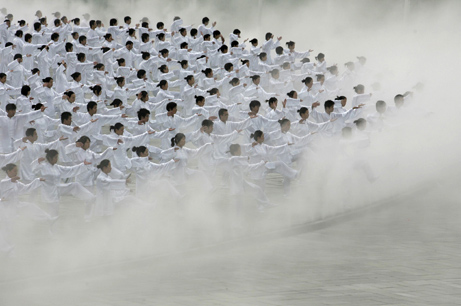
On October 30, 2008, "Snowstorm Leopard" was named best overall photo in the 2008 Wildlife Photographer of the Year competition, which is organized by the Natural History of London and BBC Wildlife Magazine.
"This is the hardest story I have ever done because of the altitude and
the steepness of the mountains," the U.S. photographer told National Geographic. "At night it was 30 below zero [Fahrenheit]."
Over ten months Winter's 14 "camera traps" shot more than 30,000 frames in pursuit of the endangered cat. (See more snow leopard photos by Winter.)
As few as 3,500 snow leopards remain in the wild.
(The National Geographic Society owns both National Geographic News and National Geographic magazine.)
~~~~~~~~~~~~~~~~~~~~~~~~~~~~~~~~~~~~~~~~~~~~~
One of The Week In Photos
Shiyan, China, October 24, 2008--Participants
rehearse Chinese Taiji boxing moves performed during the opening
ceremony of the Third World Traditional Wushu Championship on Tuesday.
The Chinese martial arts championships attracted nearly 2,000
athletes from 69 countries including first-time participants such as Colombia and Brunei, according to the Xinhua news agency, which called Wushu "the quintessence of Chinese culture."
The 300 competitions include events in tai chi and weapons categories such as the broadsword and spear.
—Photograph by Reuters

Iceman May Have No Living Relatives
October 30, 2008
The oldest intact human mummy, the Iceman, comes from a genetic line that has either died off or become extremely rare, according to a new DNA study.
The 5,200-year-old Ötzi was discovered frozen in a glacier along the border between Austria and Italy in 1991.Read more...
https://news.nationalgeographic.com/news/bigphotos/9062865.html
Oldest Malarial Mummies Shed Light on Disease Evolution
Egyptian mummies with malaria and two skeletons from Israel that had tuberculosis are helping scientists understand how and why disease-causing organisms evolve. |
Deadly Bat Disease Linked to Cold-Loving Fungus
A fungus associated with Arctic and Antarctic soils has infected bat colonies in the northeastern U.S., though it's unknown if the organism kills the mammals, a new study says. |
Candy Facts: Halloween Treats From Ancient Recipes
From Roman fig-cumin balls to medieval candied violets, a number of authentic, old-school treats can be bought or made to delight, surprise, or perhaps repulse your Halloween guests. |
Innovation Linked to Human Migration Out of Africa
Early Homo sapiens began to spread around the globe amid social and tool-making advances, not climate change, as previous research had suggested, a new study says. |
PHOTO: From the World of Fungi, a New Disease-Fighter?
A new species of fungus discovered in Belize also represents a new genus from a group used in Asian herbal medicines and immune disease treatment. |
VIDEO: Proof of Bible's King David?
The oldest known Hebrew inscription has reportedly been found where David and Goliath are said to have fought in Israel. If the controversial claim is true, it bolsters biblical accounts. |
WEEK IN PHOTOS: Hubble's Return, Wushu Dustup, and More
Hubble's snaps back with a stunning shot, martial artists kick up a dust storm, and more in the week's best news photos. |
THE ROUNDUP: Science and Nature News Around the Web
Oldest Hebrew text found; bat-killing fungus identified; Mercury's secrets revealed during flybys; and more. |



